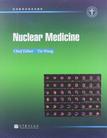Nuclear Medicine-核医学
2012-6
王铁 高等教育出版社 (2012-06出版)
王铁 编
174
The improvement of textbooks is an important part of curriculum construction in the university. To meet the needs of the foreign students' education, as well as the English teaching and bilingual teaching in the Capital Medical University, we have tried to develop the English textbook of nuclear medicine. It is a great challenge to edit the English textbook for us. We sincerely hope that this textbook can meet above needs.
Chapter 1 General Introduction of Nuclear Medicine 1.1 Basis of Nuclear Medicine 1.2 Radiopharmaceuticals 1.3 Nuclear Medicine Equipment and Nuclear Medicine Methods Chapter 2 Respiratory System 2. 1 Introduction 2.2 Lung Perfusion Imaging 2.3 Lung Ventilation Imaging 2.4 Clinical Applications Chapter 3 Neural System 3. 1 Introduction 3.2 Cerebral Blood Flow Perfusion Tomography and the Quantification of Regional Cerebral Blood Flow 3.3 Energy Metabolism 3.4 Neurotransmitter and Receptor Imaging 3.5 Compared to the Other Imaging Modalities Chapter 4 Nuclear Cardiology 4. 1 Myocardial Perfusion Imaging 4.2 Radionuelide Ventriculography 4.3 Myocardial Metabolic Imaging with 18F-FDG 4.4 Imaging Myocardial Infarction 4.5 Cardiac Neural Innervation Imaging 4.6 Advancement Chapter 5 Endocrine System 5.1 Thyroid Imaging 5.2 The Parathyroid Glands Imaging 5.3 The Adrenal Glands Imaging Chapter 6 The Urinary Tract 6. 1 Dynamic Renography 6.2 Vesieoureteral Reflux (VUR) 6.3 Renal Static Scintigraphy Chapter 7 Digestive System 7. 1 Liver Imaging 7.2 Liver Blood Pool Scintigraphy 7.3 Hepatobiliary Scintigraphy 7.4 Gastrointestinal Scintigraphy 7.5 Heterotopic Gastric Mucosa 7.6 Gastrointestinal Motility 7.7 C-14 Urea Breath Test Chapter 8 Skeletal Scintigraphy 8.1 Theory and Methods 8.2 Imaging Analysis and Results Judgment 8.3 Clinical Application 8.4 Compare to Other Imaging Methods Chapter 9 Nuclear Medicine Imaging for the Tumor 9.1 Introduction 9.2 Nuclear Oncology and its Classification 9.318F-FDG PET and PET/CT Imaging in Tumor 9.4 Tumor Imaging with Other Positron-emitting Agents but 18F-FDG 9.5 SPECT and SPECT/CT Imaging in Tumor Chapter 10 In Vitro Immunoassay 10. 1 Introduction 10.2 Radioimmunoassay 10.3 Immunoradiometric Assay 10.4 Other in Vitro Radioassay 10.5 Nonradioactive Labeled Immune Analysis 10.6 The Clinical Application of in Vitro Radioassay Chapter 11 Hematopoietic System and Lymphatic System 11.1 Hematopoietic System 11.2 Lymphatic System Chapter 12 Radionuclide Therapy 12. 1 Radioiodine Therapy with I-131 in Thyroid Disease 12.2 Radionuclide Therapy in Oncology 12.332P Therapy in Polycythemia Vera and Essential Thrombocythemia 12.4 Radionuclide Interventional Therapy 12.5 Radionuclide Application Therapy 12.6 Radionuclide Targeted Therapy 12.7 Other Radionuclide Therapies
版权页: 插图: 1.2. 7 Consideration before Nuclear Medicine Performing 1. 2. 7. 1 Radiopharmaceuticals interaction with drugs There is considerable evidence that radiophar maceutical biodistribution or pharmacokinetics may be altered by a variety of drug. For example, inter-actions leading to poor organ visualization may require a procedure to be repeated, thereby resulting in excess (unnecessary) irradiation of organs or even misdiagnosis. 1.2.7. 1.1 Desirable drug interaction of radio-pharmaceuticals Drugs interaction with radiobiocomplexes(DIR) can be successfully used in certain examina-tions, such as: (1) Adenosine and dobutamine in cardiac evaluations. (2) Acetazolamide in brain imaging. (3) Furosemide for evaluations of obstructiveuropathy. (4) Captopril in the studies of nonvascular hy-pertension. (5) Cholecystokinin in the hepatobiliary evalua-tions for confirming chronic calculous biliary disease. 1.2.7. 1.2 Undesirable drug interaction and the bioavailability of radiopharmaceuticals (1) Drugs or pharmaceuticals with iodide in their formulation, may directly affect thyroid ima ging. Somatostatin also interferes with thyroid ima-ging through the same mechanism; Inorganic iodine-containing medications such as Lugol's iodine as well as some vitamin/mineral supplements, are thought to release iodine thereby decreasing the specific activity of iodide in the body pool ; Perchlorate andpertechnetate ions, act as competitive inhibitors of the iodine transport mechanism. This can lead to de-creased uptake of I sodium iodide. (2) Cytotoxic and antimetabolites drugs such ascyclophosphamide, vincristine, cytarabine andmethotrexate, are reported to affect the pharmacoki-netic response of radiopharmaeeuticals, particularly the tumor seeking radiopharmaceutical Ga. (3) Over 20 medicines have the potential to interfere with the biodistribution of radioiodinated,meta-iodobenzylguanidine (MIBG), sometimes manyhours after they have been taken. Among those, themost commonly encountered interacting agents arechlorpromazine; clomipramine, diltiazem,dopamine,fluphenazine, labetalol, mazindol, nifedipine,promethazine and salbutamol. This interference isenough to impact the efficacy of MIBG as a diagnostic and therapeutic modality because of the extremely low quantities of radiolabeled MIBG thatare present in the organ. Therefore, it is recommended that treatment with any potentially interac-ting drug be stopped one week prior to imagingwith MIBG.
《医学教育改革系列教材:核医学》可供高等医学院校临床医学(五年制、长学年制)、口腔医学、预防医学、法医学、护理学(五年制)使用。也可供研究生、临床各科医师作为参考书使用。
